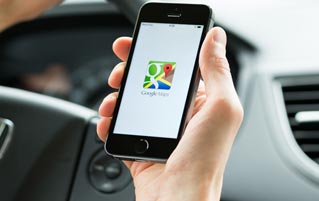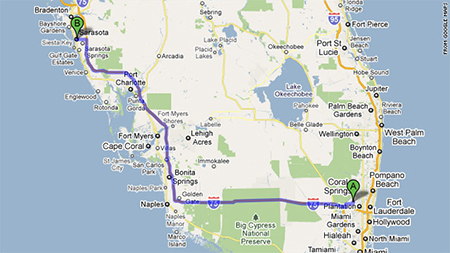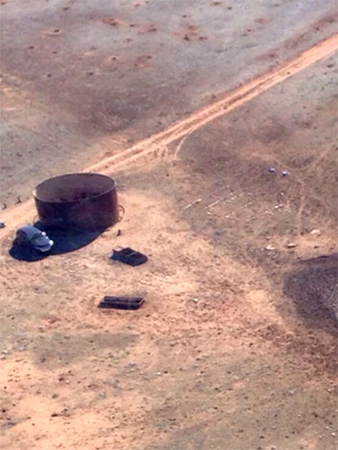7 Times Google Maps Straight Up Ruined People's Lives

Have you ever gotten mad at Google Maps for underestimating how long a road trip would take, or telling you to turn left when it was really more of a light merge? How about for nearly leading you to an agonizing death in the desert, or nudging nations ever so slightly closer to nuclear war? People, companies, and even governments have blindly followed Google Maps to such disastrous destinations. You'd almost think the app is getting its revenge for all the times we've asked it to look at "Batman, Turkey." Here are seven landmark cases in Google Maps v. Humanity.
An Error Got The Wrong House Demolished
You remember planning to have your house demolished. It takes scheduling and meeting contractors and signing documents and a whole lot of red tape. It's not an impulse decision, to say the least. Which is why a Texan woman was a tad surprised to find that she had apparently OK'd a crew to tear down her home.
"I'm sorry, but I have the 'destroying your house' papers right here, and you don't have the 'not destroying your house' form."
Lindsay Diaz came home one day to find that her life was ruined by the kookiest of mishaps. Her house had been completely demolished by Billy L. Nabors Demolition, whose slogan is "We could wreck the world -- Jesus saves," which is the demolition man's version of "Kill 'em all and let God sort them out." When confronted, the company insisted that they had been contracted to tear down 7601 Cousteau Drive. The only problem was that Diaz's address was 7601 Calypso Drive, which for Google Maps somehow counted as "close enough."
A spokesperson for Google admitted, "Both addresses were shown as being in the same location on Google Maps," adding that "the issue was fixed as soon as it was brought to our attention." Thank goodness they corrected that glitch after the demolition. That solves everything! At least now the pizza delivery guy won't get lost when he's bringing an order to the pile of rubble.
Afterwards, the demolition company issued this heartfelt statement to a very angry Diaz: "It's not a big deal." Sure, who among us has not accidentally unleashed a brigade of steel machines to rip apart a woman's life, then looked over, saw the street sign, and went "Whoopsie daisy"? Let he who is without sin cast the first stone at the glass house, Ms. Diaz. Well, she doesn't have a house anymore, so she can throw all the stones she likes.
Google Maps Keeps Straight Up Losing Cities
The city of Sunrise, Florida is home to 90,000 people, the NHL's Florida Panthers, and one of the biggest malls in the country. But for a full month, it didn't exist, as Google Maps had essentially turned it into that "Here be dragons" spot on medieval maps.

When people tried googling any place in Sunrise for 30 days in 2010, Google Maps instead directed them to Sarasota, a separate town 200 miles away, resulting in a lot of confusion and a lot of cold Deliveroo meals. And Sunrise isn't the first city Google Maps has turned into Nowheresville, USA, either. Others that have taken the same trippy trips to nonexistence include La Jolla and Imperial Beach in California, Rogers in Minnesota, Wickliffe in Ohio, and Woodstock, Virginia. No, not that Woodstock, though that would have been a great prank to pull on all those aging hippies.
But Sunrise is still special because it seems Google Maps really wants to wipe it off itself. Mike Ryan, the mayor of the alleged city, claims that this has happened not once but three separate times, with catastrophic effects. Local businesses have watched orders fall off a cliff, and residents couldn't locate emergency services like police or fire stations, medical care centers, Dunkin' Donuts, etc. "It felt like a bizarre novel -- that all of a sudden we disappeared. We woke up one morning and we didn't exist in the ether world," said one ethereal voice through the wind.
A Woman Almost Died In The Desert Because Google Made Up A Road
Picture, if you will, a woman driving to the Grand Canyon. Hard to miss, no? But that wasn't the case for one Amber VanHecke, who, relying on her Google Maps, went to see the iconic landmark but instead took a turn for the doesn't exist.
In 2017, 24-year-old VanHecke had embarked on a solo trip to the Grand Canyon. In the middle of the Arizona desert, she noticed that she only had 70 miles' worth of gas left in the tank. Not an issue, as her Google Maps reassured her that she was only 35 miles away from a highway. Trusting Google, she obediently followed the app to bring her safely to civilization. Instead, Google told her to turn onto a completely nonexistent road, which led her to a nonexistent spot on the map. And then she ran out of gas.

Fortunately for VanHecke, she was a former girl scout and well-prepared. With 18 days' worth of water, dried fruit, and Goldfish (surely one of the main currencies in the coming post-apocalypse), VanHecke took it slow and steady. She made a giant "HELP" sign out of rocks and tried to get the attention of planes flying overhead with signal fires and a flashing headlamp, but had no luck. On the plus side, instead of encountering a family of cannibalistic mutants, she spent her desert days cooking ramen on her dash and befriending a family of prairie dogs who came right up to her and ate out of her hand. Imagine if Pixar made a Mad Max movie, and you're close to understanding her harrowing experience.
Finally, after five days, with her supplies dwindling and cartoon buzzards probably circling overhead, she decided to hike 11 miles through the desert to get faint cell reception, then squeezed out a 40-second 911 call. Authorities eventually found her car, waited for her to come back, and were able to rescue her before any harm came to her -- or before she started eating her new prairie dog family. Whatever came first.
Maps Sends Tourists Visiting Landmarks To The Middle Of Nowhere
Tourists need maps like they need sunscreen for their ever-burning red noses. That's why you'd think Google would try very hard to have its maps be top-notch when it comes to directions to the most visited spots in the world. Well, much like the turns taken by many a confused tourist, you'd be wrong.
Looking for Mount Rushmore? If you use Google Maps to get you there, then you may wind up at some random snowy hill 13 miles away from the presidential bobbleheads. It has happened so often that they even had to put up a sign.
Looking to gaze at the beautiful vista of the Preikestolen cliff in Norway? Google Maps might send you a tiny unrelated fjord town called Fossmork instead. Fortunately, it's only 19 miles away and they've grown totally used to redirecting jilted-by-Google tourists to the actual landmark.

But at least those misdirections still give you a bit of the majesty of nature to look at. Meanwhile, for years, tourists wanting to see Blue Mountains National Park in Australia would wind up getting lured into a random, nondescript cul-de-sac in a residential neighborhood 20 miles away. Cars and buses full of tourists kept showing up by the minute, with some of them sometimes even knocking on doors and asking for directions or to use peoples' bathrooms. And on a scale of 1 to Beautiful Nature, using a stranger's toilet in the suburbs is only about a 5.
A Woman Sues Google For Letting Everyone Street-View Her Boobs
Who amongst us hasn't spent the better part of an hour scanning Google Maps looking at our own home from every possible side? But when one Montreal woman checked out her house on Google Maps, she saw one side she hadn't expected -- that of her boob.

She had been sitting on her front steps, flipping through her phone as us life connoisseurs are wont to do, when that lovable scamp the Google Car drove by and picked her up on film. Noticing the car, she later checked out her home on Google Street View. That's when she discovered a very unfortunate wardrobe malfunction: Her tank top was hanging down at just the right enough angle to expose her boob to the world's largest public satellite mapping system. Not only that, but her home address and car license plate were also visible in the shot, meaning local internet creeps could ask Google Maps to give them the most efficient stalking directions to a scantily clad lady living in a house with massive windows.
Google defended itself by claiming they had properly blurred her face -- which if anything only made it harder for everyone to keep looking at her at eye level. She sued Google for violating her privacy, and a small-claims court in Quebec agreed with her that a face blur did indeed fall a bit short of protecting her identity. The court awarded her a $2,250 settlement plus interest and $159 in court fees; she initially filed for $7,000, but clearly, that was asking a little much from a simple mom and pop shop like Google.
A Hacked Google Maps Destroyed Several Businesses
Knowing that most people never look past the first hit on Google, many small business owners rely on Google Maps to give customers information about their shops. But in 2010, several Buffalo-based jewelry stores noticed their business drying up out of nowhere. Why? Because someone had told Google to shut them down.

The jewelers found that their Google Maps info was telling customers they were "permanently closed," which killed off everything but foot traffic coming to the stores. A web consultant pinned these sudden changes on a rival jewelry store in their area, which was also caught spamming rivals with bad ratings, raising their own ratings, and tampering with the underlying Google information in order to change their status. For targeting jewelry stores, that must be the dumbest version of an Ocean's 11 long con ever -- no diamonds, just a better Yelp rating.
This hack isn't an isolated incident, either. A restaurant called the Serbian Crown, one of the only places in the U.S. that serves lion meat, lost 75 percent of its business seemingly overnight, and it wasn't because people were finally put off by eating lion meat. After months of bad business, a customer finally phoned asking why the restaurant was closed Saturdays, Sundays, and Mondays. Without the owners' knowledge, the Google Maps page had been displaying that they were closed three out of seven days a week, and because munching on exotic animals doesn't exactly draw a lot of walk-ins, the loss of revenue caused the restaurant to shutter.
So why is it so easy for any schmo to hack the Google Maps business info section? Though it looks very fancy with its satellites, the app is treated like any other Google page, which means it's largely crowdsourced -- i.e. super vulnerable to interference. In 2014, a hacker even tampered with the FBI and Secret Service Google pages to make a point about these flaws, and successfully managed to record all incoming phone calls to both locations. The Secret Service thanked him for exposing this weakness, presumably by hooking him up to an electric "thanking machine."

Google Takes Sides On Contested Borders And Increases Geopolitical Tensions
We've all had that moment when we got raging mad at Google Maps for taking us to the wrong side of the street from where we know the McDonald's ought to be. But did you know that countries have the exact same problem? Only their notions of which side should have what can quickly involve border war and missiles? We've talked before about that time Nicaragua accidentally invaded Costa Rica thanks to a Google Maps error, but it turns out that this sort of thing isn't even a rare mishap for Google. It's par for the course.

Like the cartographers of yore, when countries dispute borders, it's Google Maps' job to (literally) draw the line somewhere. But unlike in ye medieval times, Google has more than enough space and technology to make it so that all variants of contested borders are constantly shown on its map. But instead of doing that smart, sane thing, Google shows people world maps based on the political stances of whatever countries they're accessing from. If your government doesn't recognize a certain other government or border dispute, you don't get to see that. In an attempt to stay out of politics, Google Maps agrees with whatever country your IP address is showing.
For example, the U.S. views Crimea as "occupied territory," and accessing Google Maps in the U.S. will display Crimea with a dotted border, denoting its disputed status. But in Russia, Google Maps counts Crimea as part of Russia, with no border ambiguity. Similar disputes have cropped up throughout Google's history, forcing the company into some pretty tricky political situations, like accidentally giving a German harbor to the Netherlands as if it's trying to get World War III going.

But that's not the only way Google is making governments angry. India's high court blasted Google Maps for publicly displaying the location of their (obviously not that secret) secret military bases, particularly ones that were close to their border with on-again / off-again enemy Pakistan. So the next time you're mad at Google for forcing you into a blind left that clearly takes two minutes to complete instead of one, at least take some solace in the fact that it didn't guide you into a nuclear war. And really, isn't that a reasonable standard to hold map technology to?
Forget Google Maps, just grab a Rand McNally and hope for the best.
Support Cracked's journalism with a visit to our Contribution Page. Please and thank you.
For more, check out The 5 Weirdest Things I Saw Driving For Google Street View and The 24 Most Mind-Blowing Photos Accidentally Taken By Google.
You can't go wrong by following us on Facebook.
